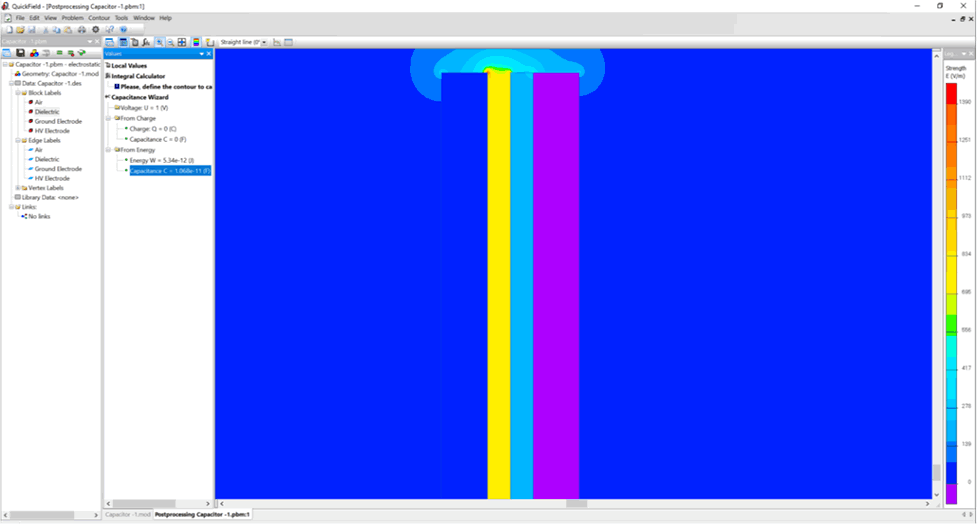QuickField Software package in undergraduate teaching at the Department of Electronic and Electrical Engineering of University of Strathclyde
Dr. Igor Timoshkin, Dr. Martin Given (University of Strathclyde).
Electromagnetism is one of the core modules taken by the undergraduate students who are studying at the Department of Electronic and Electrical Engineering, University of Strathclyde, Glasgow. This module provides the fundamental knowledge in electrostatics and magnetism and helps to build the basis for further studying of complex electromagnetic phenomena. As a part of this module, undergraduate students undertake two laboratory activities focused on the design of capacitors and inductors, developing an understanding of the principals behind capacitors and inductors and on the analysis of their characteristics. In this academic year, due to COVID restrictions it was necessary to run these two laboratories in an on-line format to provide undergraduate students with experience in modelling and characterisation of these important engineering components in an industrial quality virtual environment. The software package which was selected for this activity was QuickField Professional finite element analysis software package by Tera Analysis Ltd. This software provides an intuitive and straightforward graphic utility interface, which is important for undergraduate students who may not have previous experience in using electromagnetic simulation software. The QuickField package was installed on the Electronic and Electrical Engineering departments undergraduate laboratory PC’s and students were provided with a virtual desktop access to this software allowing them to run their simulation models remotely.
The first laboratory activities were focused on the development of capacitor models including capacitors filled with multilayer dielectric materials. The electric field distribution in the dielectric layers was explored and their capacitance values were obtained using the Capacitance calculator provided by QuickField. The students then compared their modelling results with the results obtained by the analytical equations. This electrostatic modelling allowed students to understand the field distribution in complex dielectric systems and provided them with experience in analysis of the fringe effects and effects of dielectric permittivity on the electric field distribution and capacitance value. Figure 1 shows an example of the multilayer capacitor and the field distribution in this capacitor obtained during these laboratory activities.
The second laboratory activity was focused on the modelling of solenoids with cores with different relative permeability values. The students modelled the magnetic field and obtained the electromagnetic flux depending on the relative permeability and turn number values, the Inductance calculator embedded into the QuickField package was used to obtain the values of inductance in each specific case and compare QuickField results with theoretical calculations.

Figure 1. Electric field distribution in the capacitor with two layers of dialect materials between parallel plane electrodes.
QuickField software package was also used to support teaching in the final year undergraduate and taught master course focused on High Voltage Technologies. In the framework of this class several computer-based laboratory activities have been developed. The students need to develop an understanding of the electric field distribution in different high voltage systems such as cables, insulators, and gas insulating lines. QuickField provides an excellent opportunity for students to model complex dielectric systems and to investigate the electric field enhancement in gas filled voids in solid and liquid insulators (Figure 2) and the non-uniform field distribution in complex topologies (Figure 3). This modelling provides students with experience and expertise in analysis of the electrostatic fields in different high voltage systems.

Figure 2. Axisymmetric simulation of the field distribution around an air-filled void in a dielectric.

Figure 3. Axisymmetric simulation of a transformer bushing without field grading.
The QuickField electrostatic package is also used at the Department of Electronic and Electrical Engineering to support undergraduate and postgraduate projects. These students learn how to use the Quickfield Professional interface to build 2D and axisymmetric models, and in certain advanced topologies 3D models created in CAD software have been used. The QuickField software package is an efficient tool for modelling the electrostatic and magnetic fields relevant to Electronic and Electrical engineering. This provides an excellent opportunity for undergraduate students to learn how to model these fields in different practical scenarios and how to use these models to solve relevant engineering problems. The teaching staff at the Department of EEE who are involved in delivering these classes plan to continue to use QuickField finite element analysis software in their teaching activities and would like to express their gratitude to Tera Analysis Ltd and UK QuickField distributor Temati-UK Ltd for their continuing support.